Business & Environment: NLCCE Organization Report and Analysis
VerifiedAdded on 2023/01/11
|13
|4115
|25
Report
AI Summary
This report delves into the intricacies of the business environment, examining the interplay of internal and external factors that influence organizational performance. It begins by defining the business environment and its importance, followed by an analysis of different organizational types: private, public, and voluntary sectors, along with their respective legal structures. The report then explores the size and scope of various organizations, including large, medium, and small enterprises, as well as transnational and international organizations. Key organizational functions, such as marketing, finance, operations, and human resources, are examined, highlighting their interrelationships and how they contribute to achieving organizational objectives and structure. The report further identifies and analyzes the positive and negative impacts of the macro environment, using the PESTEL framework and specific examples related to the UK. Finally, it conducts internal and external analyses of the NLCCE organization, identifying its strengths and weaknesses and explaining how these factors interrelate with external macro factors. The report concludes with recommendations based on the analysis.
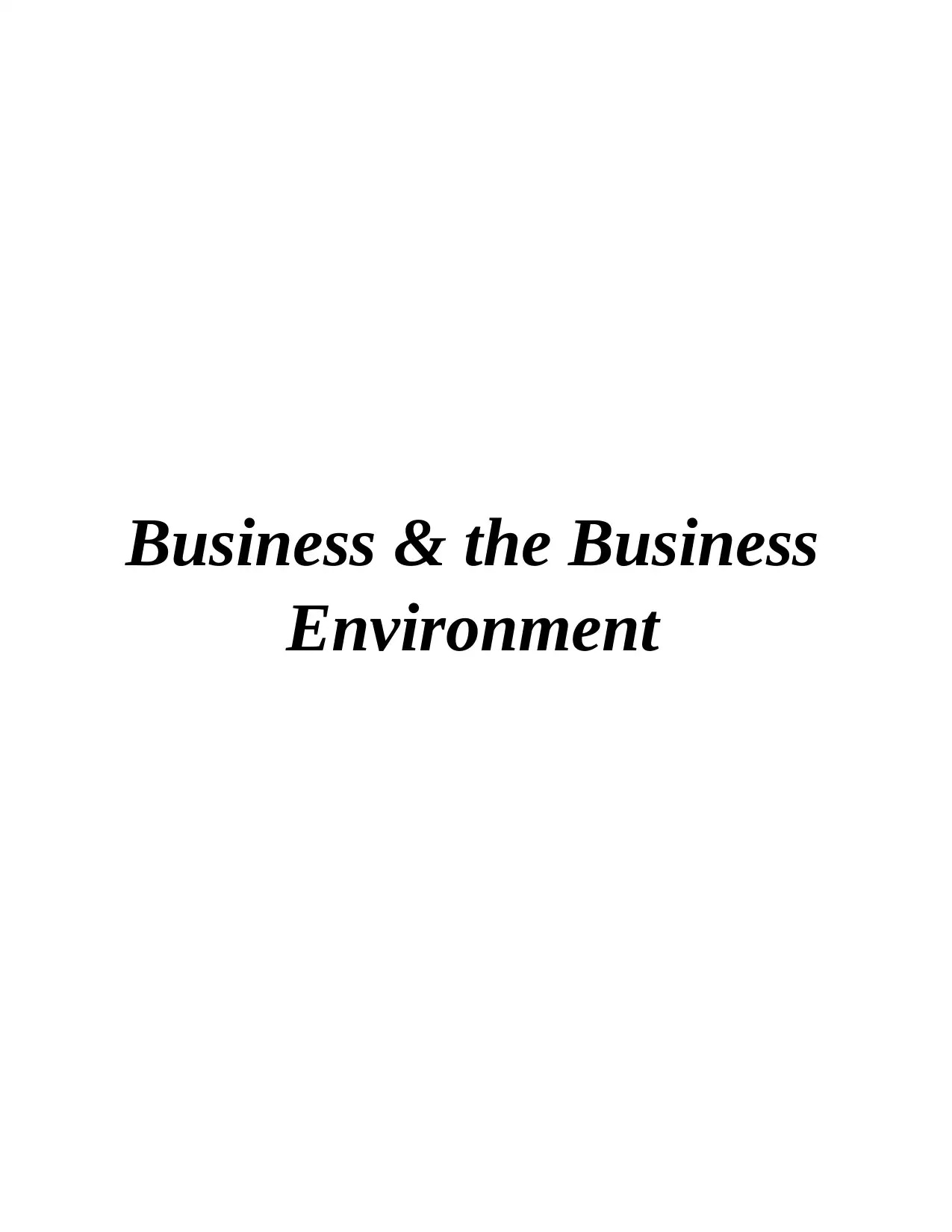
Business & the Business
Environment
Environment
Paraphrase This Document
Need a fresh take? Get an instant paraphrase of this document with our AI Paraphraser
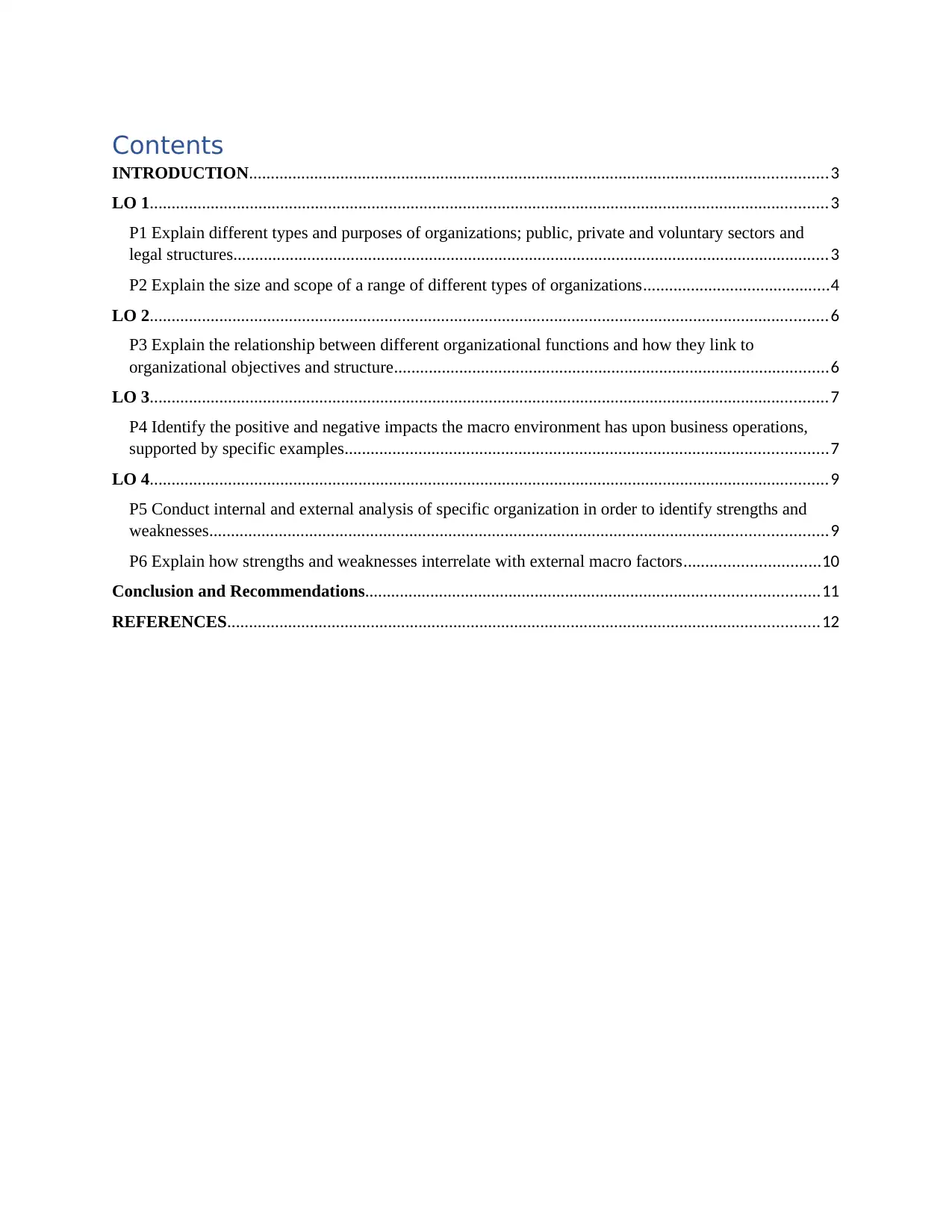
Contents
INTRODUCTION.....................................................................................................................................3
LO 1............................................................................................................................................................3
P1 Explain different types and purposes of organizations; public, private and voluntary sectors and
legal structures.........................................................................................................................................3
P2 Explain the size and scope of a range of different types of organizations...........................................4
LO 2............................................................................................................................................................6
P3 Explain the relationship between different organizational functions and how they link to
organizational objectives and structure....................................................................................................6
LO 3............................................................................................................................................................7
P4 Identify the positive and negative impacts the macro environment has upon business operations,
supported by specific examples...............................................................................................................7
LO 4............................................................................................................................................................9
P5 Conduct internal and external analysis of specific organization in order to identify strengths and
weaknesses..............................................................................................................................................9
P6 Explain how strengths and weaknesses interrelate with external macro factors...............................10
Conclusion and Recommendations........................................................................................................11
REFERENCES........................................................................................................................................12
INTRODUCTION.....................................................................................................................................3
LO 1............................................................................................................................................................3
P1 Explain different types and purposes of organizations; public, private and voluntary sectors and
legal structures.........................................................................................................................................3
P2 Explain the size and scope of a range of different types of organizations...........................................4
LO 2............................................................................................................................................................6
P3 Explain the relationship between different organizational functions and how they link to
organizational objectives and structure....................................................................................................6
LO 3............................................................................................................................................................7
P4 Identify the positive and negative impacts the macro environment has upon business operations,
supported by specific examples...............................................................................................................7
LO 4............................................................................................................................................................9
P5 Conduct internal and external analysis of specific organization in order to identify strengths and
weaknesses..............................................................................................................................................9
P6 Explain how strengths and weaknesses interrelate with external macro factors...............................10
Conclusion and Recommendations........................................................................................................11
REFERENCES........................................................................................................................................12
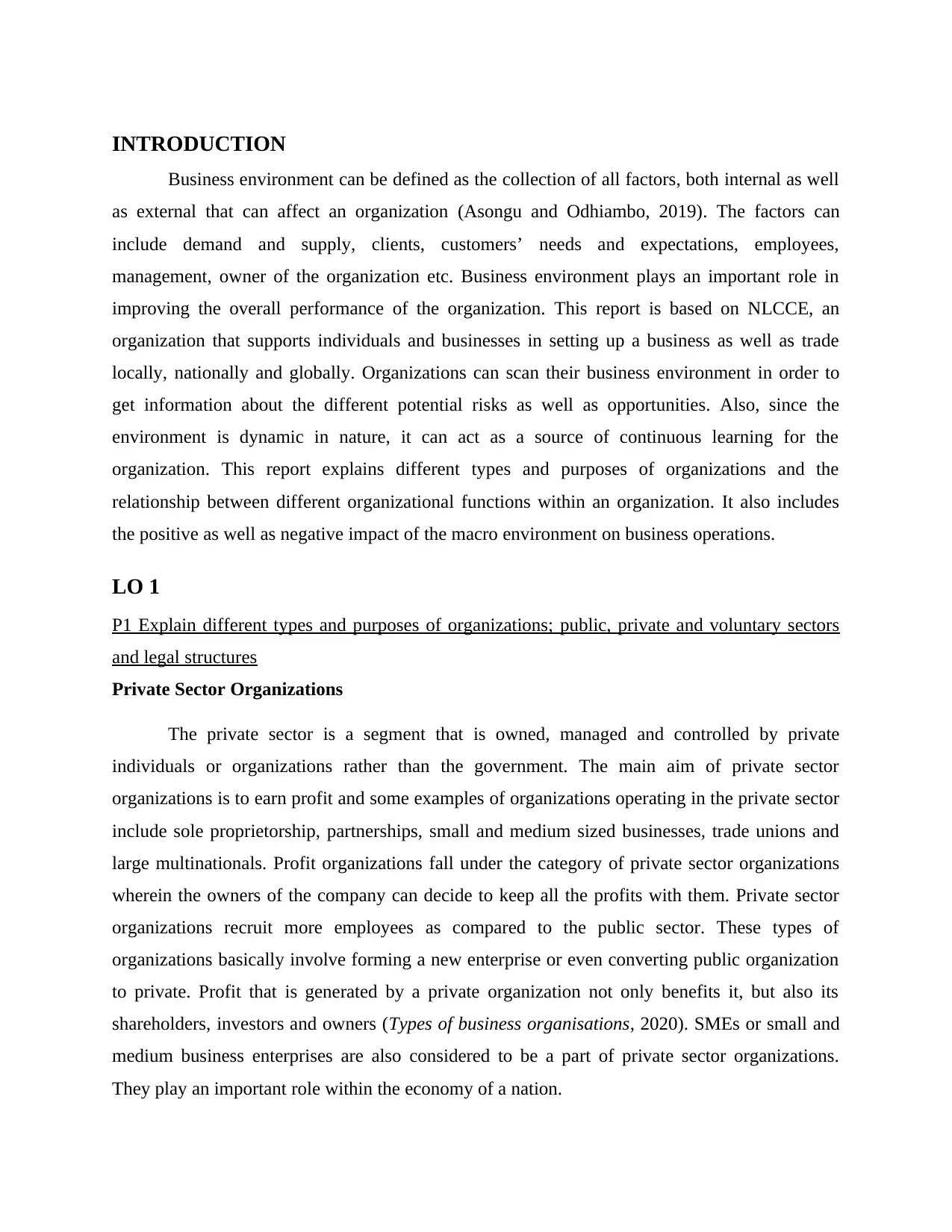
INTRODUCTION
Business environment can be defined as the collection of all factors, both internal as well
as external that can affect an organization (Asongu and Odhiambo, 2019). The factors can
include demand and supply, clients, customers’ needs and expectations, employees,
management, owner of the organization etc. Business environment plays an important role in
improving the overall performance of the organization. This report is based on NLCCE, an
organization that supports individuals and businesses in setting up a business as well as trade
locally, nationally and globally. Organizations can scan their business environment in order to
get information about the different potential risks as well as opportunities. Also, since the
environment is dynamic in nature, it can act as a source of continuous learning for the
organization. This report explains different types and purposes of organizations and the
relationship between different organizational functions within an organization. It also includes
the positive as well as negative impact of the macro environment on business operations.
LO 1
P1 Explain different types and purposes of organizations; public, private and voluntary sectors
and legal structures
Private Sector Organizations
The private sector is a segment that is owned, managed and controlled by private
individuals or organizations rather than the government. The main aim of private sector
organizations is to earn profit and some examples of organizations operating in the private sector
include sole proprietorship, partnerships, small and medium sized businesses, trade unions and
large multinationals. Profit organizations fall under the category of private sector organizations
wherein the owners of the company can decide to keep all the profits with them. Private sector
organizations recruit more employees as compared to the public sector. These types of
organizations basically involve forming a new enterprise or even converting public organization
to private. Profit that is generated by a private organization not only benefits it, but also its
shareholders, investors and owners (Types of business organisations, 2020). SMEs or small and
medium business enterprises are also considered to be a part of private sector organizations.
They play an important role within the economy of a nation.
Business environment can be defined as the collection of all factors, both internal as well
as external that can affect an organization (Asongu and Odhiambo, 2019). The factors can
include demand and supply, clients, customers’ needs and expectations, employees,
management, owner of the organization etc. Business environment plays an important role in
improving the overall performance of the organization. This report is based on NLCCE, an
organization that supports individuals and businesses in setting up a business as well as trade
locally, nationally and globally. Organizations can scan their business environment in order to
get information about the different potential risks as well as opportunities. Also, since the
environment is dynamic in nature, it can act as a source of continuous learning for the
organization. This report explains different types and purposes of organizations and the
relationship between different organizational functions within an organization. It also includes
the positive as well as negative impact of the macro environment on business operations.
LO 1
P1 Explain different types and purposes of organizations; public, private and voluntary sectors
and legal structures
Private Sector Organizations
The private sector is a segment that is owned, managed and controlled by private
individuals or organizations rather than the government. The main aim of private sector
organizations is to earn profit and some examples of organizations operating in the private sector
include sole proprietorship, partnerships, small and medium sized businesses, trade unions and
large multinationals. Profit organizations fall under the category of private sector organizations
wherein the owners of the company can decide to keep all the profits with them. Private sector
organizations recruit more employees as compared to the public sector. These types of
organizations basically involve forming a new enterprise or even converting public organization
to private. Profit that is generated by a private organization not only benefits it, but also its
shareholders, investors and owners (Types of business organisations, 2020). SMEs or small and
medium business enterprises are also considered to be a part of private sector organizations.
They play an important role within the economy of a nation.
⊘ This is a preview!⊘
Do you want full access?
Subscribe today to unlock all pages.

Trusted by 1+ million students worldwide
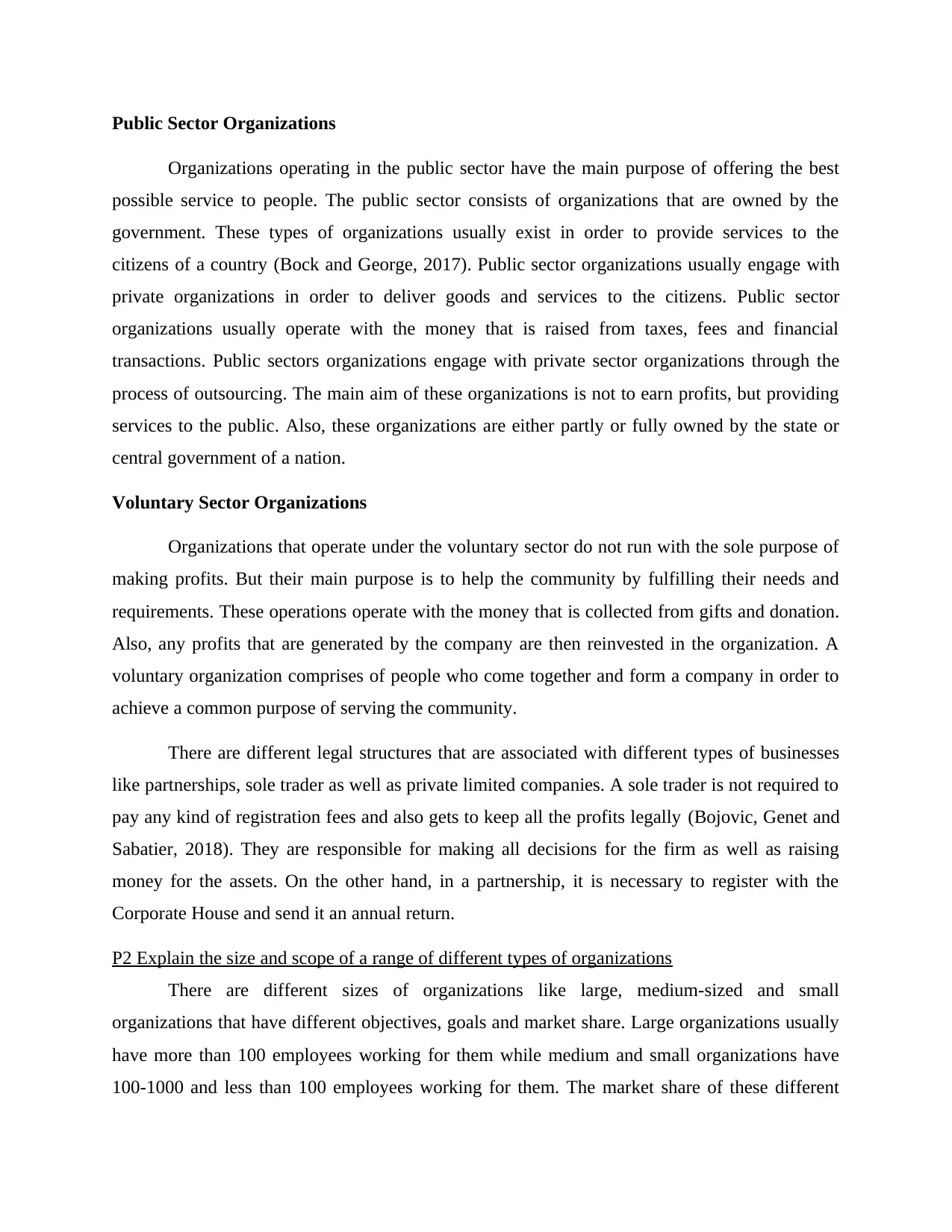
Public Sector Organizations
Organizations operating in the public sector have the main purpose of offering the best
possible service to people. The public sector consists of organizations that are owned by the
government. These types of organizations usually exist in order to provide services to the
citizens of a country (Bock and George, 2017). Public sector organizations usually engage with
private organizations in order to deliver goods and services to the citizens. Public sector
organizations usually operate with the money that is raised from taxes, fees and financial
transactions. Public sectors organizations engage with private sector organizations through the
process of outsourcing. The main aim of these organizations is not to earn profits, but providing
services to the public. Also, these organizations are either partly or fully owned by the state or
central government of a nation.
Voluntary Sector Organizations
Organizations that operate under the voluntary sector do not run with the sole purpose of
making profits. But their main purpose is to help the community by fulfilling their needs and
requirements. These operations operate with the money that is collected from gifts and donation.
Also, any profits that are generated by the company are then reinvested in the organization. A
voluntary organization comprises of people who come together and form a company in order to
achieve a common purpose of serving the community.
There are different legal structures that are associated with different types of businesses
like partnerships, sole trader as well as private limited companies. A sole trader is not required to
pay any kind of registration fees and also gets to keep all the profits legally (Bojovic, Genet and
Sabatier, 2018). They are responsible for making all decisions for the firm as well as raising
money for the assets. On the other hand, in a partnership, it is necessary to register with the
Corporate House and send it an annual return.
P2 Explain the size and scope of a range of different types of organizations
There are different sizes of organizations like large, medium-sized and small
organizations that have different objectives, goals and market share. Large organizations usually
have more than 100 employees working for them while medium and small organizations have
100-1000 and less than 100 employees working for them. The market share of these different
Organizations operating in the public sector have the main purpose of offering the best
possible service to people. The public sector consists of organizations that are owned by the
government. These types of organizations usually exist in order to provide services to the
citizens of a country (Bock and George, 2017). Public sector organizations usually engage with
private organizations in order to deliver goods and services to the citizens. Public sector
organizations usually operate with the money that is raised from taxes, fees and financial
transactions. Public sectors organizations engage with private sector organizations through the
process of outsourcing. The main aim of these organizations is not to earn profits, but providing
services to the public. Also, these organizations are either partly or fully owned by the state or
central government of a nation.
Voluntary Sector Organizations
Organizations that operate under the voluntary sector do not run with the sole purpose of
making profits. But their main purpose is to help the community by fulfilling their needs and
requirements. These operations operate with the money that is collected from gifts and donation.
Also, any profits that are generated by the company are then reinvested in the organization. A
voluntary organization comprises of people who come together and form a company in order to
achieve a common purpose of serving the community.
There are different legal structures that are associated with different types of businesses
like partnerships, sole trader as well as private limited companies. A sole trader is not required to
pay any kind of registration fees and also gets to keep all the profits legally (Bojovic, Genet and
Sabatier, 2018). They are responsible for making all decisions for the firm as well as raising
money for the assets. On the other hand, in a partnership, it is necessary to register with the
Corporate House and send it an annual return.
P2 Explain the size and scope of a range of different types of organizations
There are different sizes of organizations like large, medium-sized and small
organizations that have different objectives, goals and market share. Large organizations usually
have more than 100 employees working for them while medium and small organizations have
100-1000 and less than 100 employees working for them. The market share of these different
Paraphrase This Document
Need a fresh take? Get an instant paraphrase of this document with our AI Paraphraser
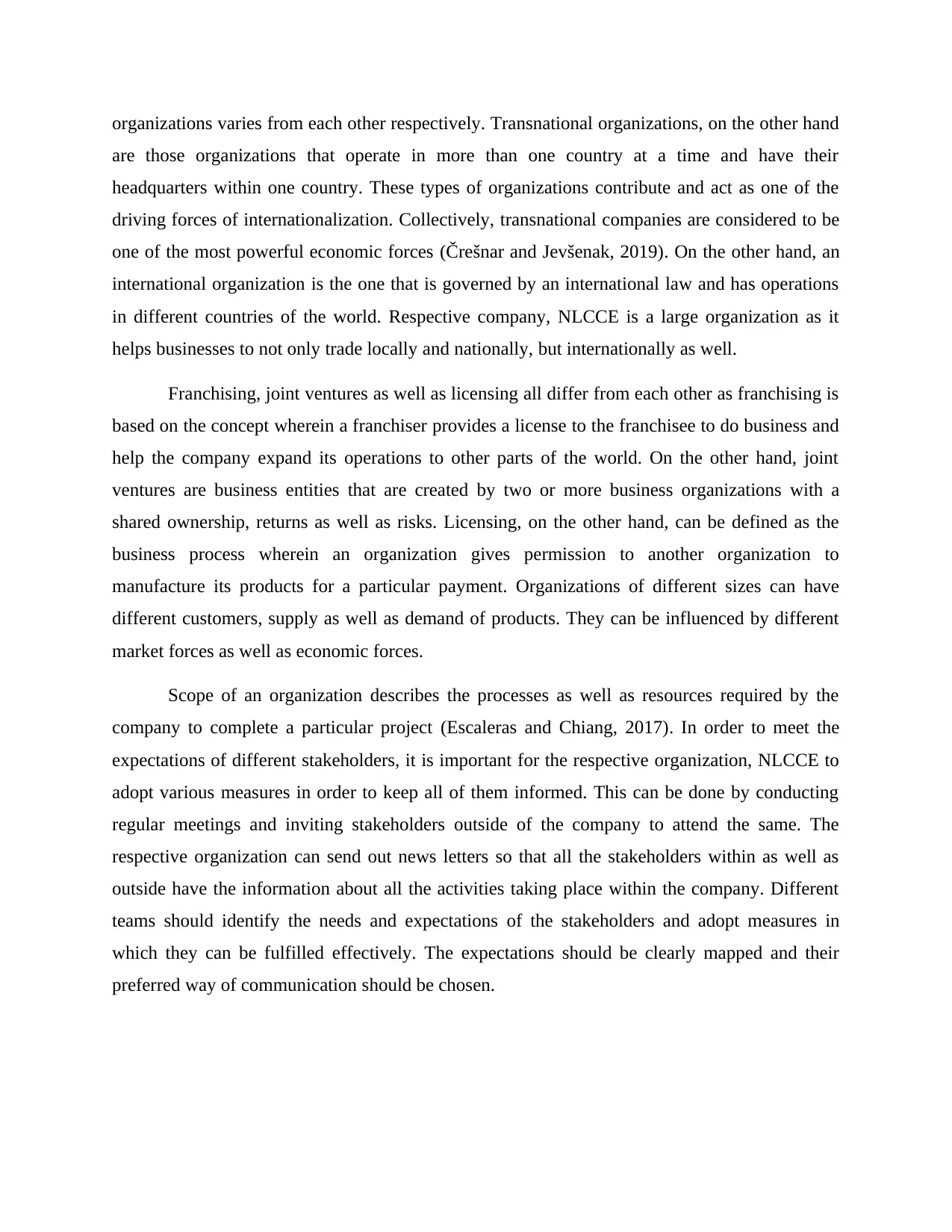
organizations varies from each other respectively. Transnational organizations, on the other hand
are those organizations that operate in more than one country at a time and have their
headquarters within one country. These types of organizations contribute and act as one of the
driving forces of internationalization. Collectively, transnational companies are considered to be
one of the most powerful economic forces (Črešnar and Jevšenak, 2019). On the other hand, an
international organization is the one that is governed by an international law and has operations
in different countries of the world. Respective company, NLCCE is a large organization as it
helps businesses to not only trade locally and nationally, but internationally as well.
Franchising, joint ventures as well as licensing all differ from each other as franchising is
based on the concept wherein a franchiser provides a license to the franchisee to do business and
help the company expand its operations to other parts of the world. On the other hand, joint
ventures are business entities that are created by two or more business organizations with a
shared ownership, returns as well as risks. Licensing, on the other hand, can be defined as the
business process wherein an organization gives permission to another organization to
manufacture its products for a particular payment. Organizations of different sizes can have
different customers, supply as well as demand of products. They can be influenced by different
market forces as well as economic forces.
Scope of an organization describes the processes as well as resources required by the
company to complete a particular project (Escaleras and Chiang, 2017). In order to meet the
expectations of different stakeholders, it is important for the respective organization, NLCCE to
adopt various measures in order to keep all of them informed. This can be done by conducting
regular meetings and inviting stakeholders outside of the company to attend the same. The
respective organization can send out news letters so that all the stakeholders within as well as
outside have the information about all the activities taking place within the company. Different
teams should identify the needs and expectations of the stakeholders and adopt measures in
which they can be fulfilled effectively. The expectations should be clearly mapped and their
preferred way of communication should be chosen.
are those organizations that operate in more than one country at a time and have their
headquarters within one country. These types of organizations contribute and act as one of the
driving forces of internationalization. Collectively, transnational companies are considered to be
one of the most powerful economic forces (Črešnar and Jevšenak, 2019). On the other hand, an
international organization is the one that is governed by an international law and has operations
in different countries of the world. Respective company, NLCCE is a large organization as it
helps businesses to not only trade locally and nationally, but internationally as well.
Franchising, joint ventures as well as licensing all differ from each other as franchising is
based on the concept wherein a franchiser provides a license to the franchisee to do business and
help the company expand its operations to other parts of the world. On the other hand, joint
ventures are business entities that are created by two or more business organizations with a
shared ownership, returns as well as risks. Licensing, on the other hand, can be defined as the
business process wherein an organization gives permission to another organization to
manufacture its products for a particular payment. Organizations of different sizes can have
different customers, supply as well as demand of products. They can be influenced by different
market forces as well as economic forces.
Scope of an organization describes the processes as well as resources required by the
company to complete a particular project (Escaleras and Chiang, 2017). In order to meet the
expectations of different stakeholders, it is important for the respective organization, NLCCE to
adopt various measures in order to keep all of them informed. This can be done by conducting
regular meetings and inviting stakeholders outside of the company to attend the same. The
respective organization can send out news letters so that all the stakeholders within as well as
outside have the information about all the activities taking place within the company. Different
teams should identify the needs and expectations of the stakeholders and adopt measures in
which they can be fulfilled effectively. The expectations should be clearly mapped and their
preferred way of communication should be chosen.
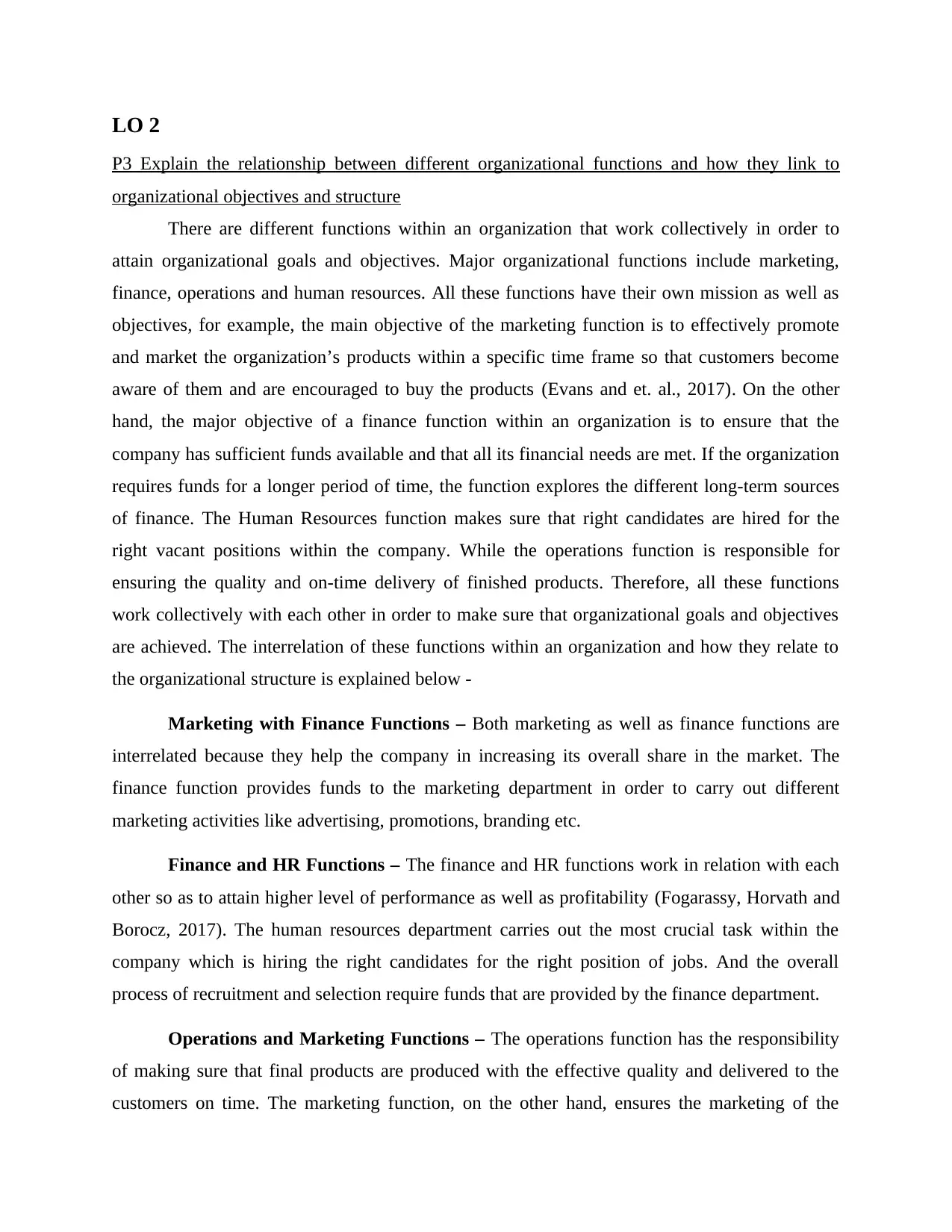
LO 2
P3 Explain the relationship between different organizational functions and how they link to
organizational objectives and structure
There are different functions within an organization that work collectively in order to
attain organizational goals and objectives. Major organizational functions include marketing,
finance, operations and human resources. All these functions have their own mission as well as
objectives, for example, the main objective of the marketing function is to effectively promote
and market the organization’s products within a specific time frame so that customers become
aware of them and are encouraged to buy the products (Evans and et. al., 2017). On the other
hand, the major objective of a finance function within an organization is to ensure that the
company has sufficient funds available and that all its financial needs are met. If the organization
requires funds for a longer period of time, the function explores the different long-term sources
of finance. The Human Resources function makes sure that right candidates are hired for the
right vacant positions within the company. While the operations function is responsible for
ensuring the quality and on-time delivery of finished products. Therefore, all these functions
work collectively with each other in order to make sure that organizational goals and objectives
are achieved. The interrelation of these functions within an organization and how they relate to
the organizational structure is explained below -
Marketing with Finance Functions – Both marketing as well as finance functions are
interrelated because they help the company in increasing its overall share in the market. The
finance function provides funds to the marketing department in order to carry out different
marketing activities like advertising, promotions, branding etc.
Finance and HR Functions – The finance and HR functions work in relation with each
other so as to attain higher level of performance as well as profitability (Fogarassy, Horvath and
Borocz, 2017). The human resources department carries out the most crucial task within the
company which is hiring the right candidates for the right position of jobs. And the overall
process of recruitment and selection require funds that are provided by the finance department.
Operations and Marketing Functions – The operations function has the responsibility
of making sure that final products are produced with the effective quality and delivered to the
customers on time. The marketing function, on the other hand, ensures the marketing of the
P3 Explain the relationship between different organizational functions and how they link to
organizational objectives and structure
There are different functions within an organization that work collectively in order to
attain organizational goals and objectives. Major organizational functions include marketing,
finance, operations and human resources. All these functions have their own mission as well as
objectives, for example, the main objective of the marketing function is to effectively promote
and market the organization’s products within a specific time frame so that customers become
aware of them and are encouraged to buy the products (Evans and et. al., 2017). On the other
hand, the major objective of a finance function within an organization is to ensure that the
company has sufficient funds available and that all its financial needs are met. If the organization
requires funds for a longer period of time, the function explores the different long-term sources
of finance. The Human Resources function makes sure that right candidates are hired for the
right vacant positions within the company. While the operations function is responsible for
ensuring the quality and on-time delivery of finished products. Therefore, all these functions
work collectively with each other in order to make sure that organizational goals and objectives
are achieved. The interrelation of these functions within an organization and how they relate to
the organizational structure is explained below -
Marketing with Finance Functions – Both marketing as well as finance functions are
interrelated because they help the company in increasing its overall share in the market. The
finance function provides funds to the marketing department in order to carry out different
marketing activities like advertising, promotions, branding etc.
Finance and HR Functions – The finance and HR functions work in relation with each
other so as to attain higher level of performance as well as profitability (Fogarassy, Horvath and
Borocz, 2017). The human resources department carries out the most crucial task within the
company which is hiring the right candidates for the right position of jobs. And the overall
process of recruitment and selection require funds that are provided by the finance department.
Operations and Marketing Functions – The operations function has the responsibility
of making sure that final products are produced with the effective quality and delivered to the
customers on time. The marketing function, on the other hand, ensures the marketing of the
⊘ This is a preview!⊘
Do you want full access?
Subscribe today to unlock all pages.

Trusted by 1+ million students worldwide
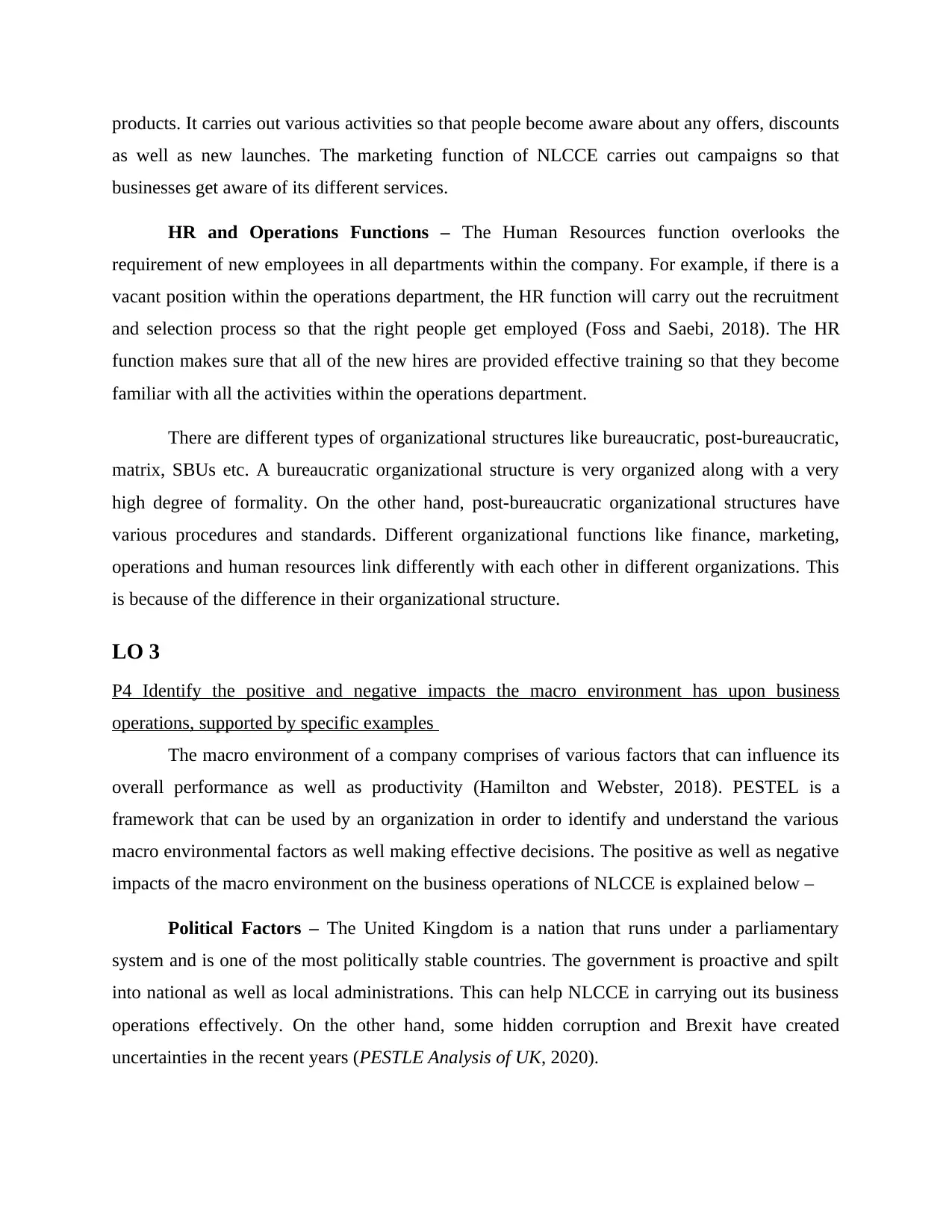
products. It carries out various activities so that people become aware about any offers, discounts
as well as new launches. The marketing function of NLCCE carries out campaigns so that
businesses get aware of its different services.
HR and Operations Functions – The Human Resources function overlooks the
requirement of new employees in all departments within the company. For example, if there is a
vacant position within the operations department, the HR function will carry out the recruitment
and selection process so that the right people get employed (Foss and Saebi, 2018). The HR
function makes sure that all of the new hires are provided effective training so that they become
familiar with all the activities within the operations department.
There are different types of organizational structures like bureaucratic, post-bureaucratic,
matrix, SBUs etc. A bureaucratic organizational structure is very organized along with a very
high degree of formality. On the other hand, post-bureaucratic organizational structures have
various procedures and standards. Different organizational functions like finance, marketing,
operations and human resources link differently with each other in different organizations. This
is because of the difference in their organizational structure.
LO 3
P4 Identify the positive and negative impacts the macro environment has upon business
operations, supported by specific examples
The macro environment of a company comprises of various factors that can influence its
overall performance as well as productivity (Hamilton and Webster, 2018). PESTEL is a
framework that can be used by an organization in order to identify and understand the various
macro environmental factors as well making effective decisions. The positive as well as negative
impacts of the macro environment on the business operations of NLCCE is explained below –
Political Factors – The United Kingdom is a nation that runs under a parliamentary
system and is one of the most politically stable countries. The government is proactive and spilt
into national as well as local administrations. This can help NLCCE in carrying out its business
operations effectively. On the other hand, some hidden corruption and Brexit have created
uncertainties in the recent years (PESTLE Analysis of UK, 2020).
as well as new launches. The marketing function of NLCCE carries out campaigns so that
businesses get aware of its different services.
HR and Operations Functions – The Human Resources function overlooks the
requirement of new employees in all departments within the company. For example, if there is a
vacant position within the operations department, the HR function will carry out the recruitment
and selection process so that the right people get employed (Foss and Saebi, 2018). The HR
function makes sure that all of the new hires are provided effective training so that they become
familiar with all the activities within the operations department.
There are different types of organizational structures like bureaucratic, post-bureaucratic,
matrix, SBUs etc. A bureaucratic organizational structure is very organized along with a very
high degree of formality. On the other hand, post-bureaucratic organizational structures have
various procedures and standards. Different organizational functions like finance, marketing,
operations and human resources link differently with each other in different organizations. This
is because of the difference in their organizational structure.
LO 3
P4 Identify the positive and negative impacts the macro environment has upon business
operations, supported by specific examples
The macro environment of a company comprises of various factors that can influence its
overall performance as well as productivity (Hamilton and Webster, 2018). PESTEL is a
framework that can be used by an organization in order to identify and understand the various
macro environmental factors as well making effective decisions. The positive as well as negative
impacts of the macro environment on the business operations of NLCCE is explained below –
Political Factors – The United Kingdom is a nation that runs under a parliamentary
system and is one of the most politically stable countries. The government is proactive and spilt
into national as well as local administrations. This can help NLCCE in carrying out its business
operations effectively. On the other hand, some hidden corruption and Brexit have created
uncertainties in the recent years (PESTLE Analysis of UK, 2020).
Paraphrase This Document
Need a fresh take? Get an instant paraphrase of this document with our AI Paraphraser
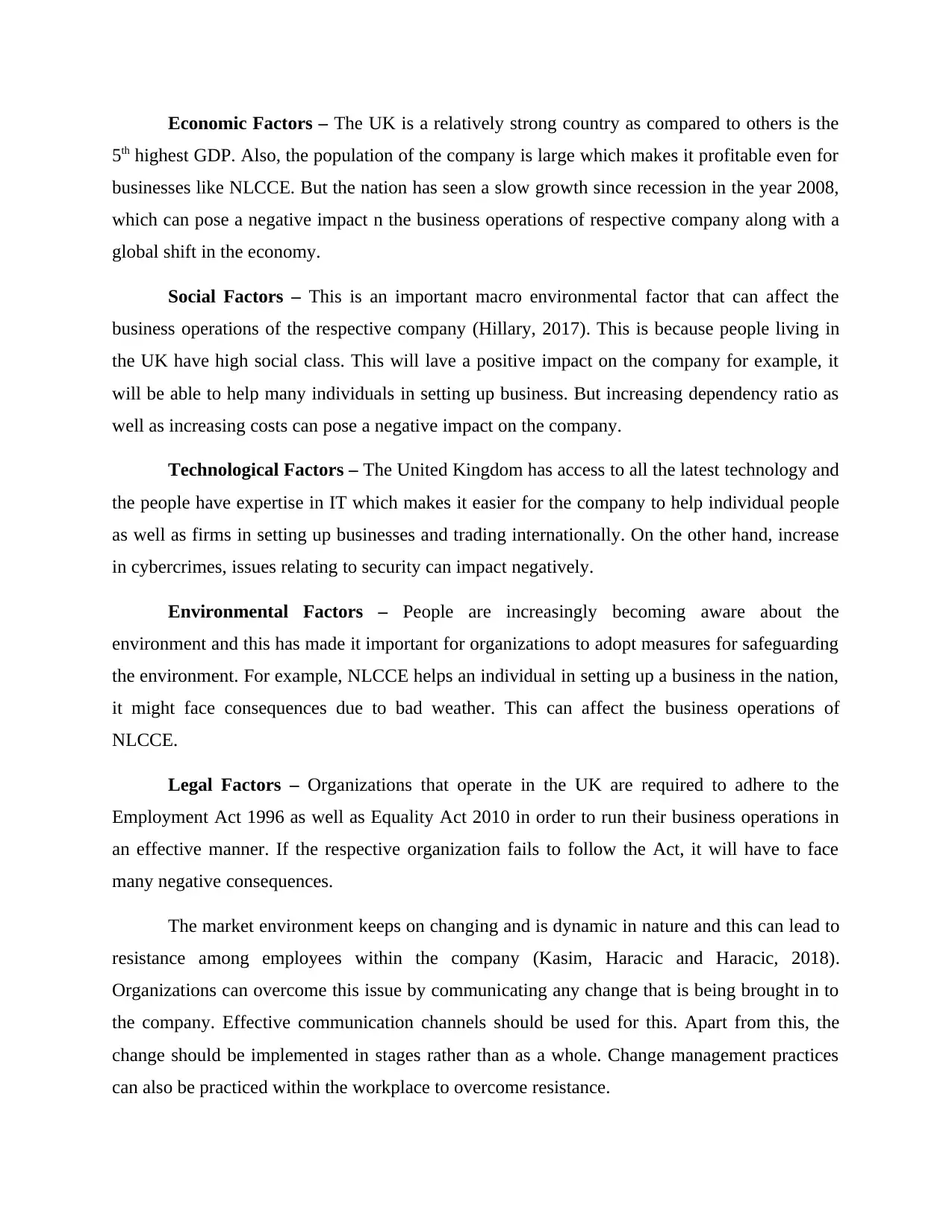
Economic Factors – The UK is a relatively strong country as compared to others is the
5th highest GDP. Also, the population of the company is large which makes it profitable even for
businesses like NLCCE. But the nation has seen a slow growth since recession in the year 2008,
which can pose a negative impact n the business operations of respective company along with a
global shift in the economy.
Social Factors – This is an important macro environmental factor that can affect the
business operations of the respective company (Hillary, 2017). This is because people living in
the UK have high social class. This will lave a positive impact on the company for example, it
will be able to help many individuals in setting up business. But increasing dependency ratio as
well as increasing costs can pose a negative impact on the company.
Technological Factors – The United Kingdom has access to all the latest technology and
the people have expertise in IT which makes it easier for the company to help individual people
as well as firms in setting up businesses and trading internationally. On the other hand, increase
in cybercrimes, issues relating to security can impact negatively.
Environmental Factors – People are increasingly becoming aware about the
environment and this has made it important for organizations to adopt measures for safeguarding
the environment. For example, NLCCE helps an individual in setting up a business in the nation,
it might face consequences due to bad weather. This can affect the business operations of
NLCCE.
Legal Factors – Organizations that operate in the UK are required to adhere to the
Employment Act 1996 as well as Equality Act 2010 in order to run their business operations in
an effective manner. If the respective organization fails to follow the Act, it will have to face
many negative consequences.
The market environment keeps on changing and is dynamic in nature and this can lead to
resistance among employees within the company (Kasim, Haracic and Haracic, 2018).
Organizations can overcome this issue by communicating any change that is being brought in to
the company. Effective communication channels should be used for this. Apart from this, the
change should be implemented in stages rather than as a whole. Change management practices
can also be practiced within the workplace to overcome resistance.
5th highest GDP. Also, the population of the company is large which makes it profitable even for
businesses like NLCCE. But the nation has seen a slow growth since recession in the year 2008,
which can pose a negative impact n the business operations of respective company along with a
global shift in the economy.
Social Factors – This is an important macro environmental factor that can affect the
business operations of the respective company (Hillary, 2017). This is because people living in
the UK have high social class. This will lave a positive impact on the company for example, it
will be able to help many individuals in setting up business. But increasing dependency ratio as
well as increasing costs can pose a negative impact on the company.
Technological Factors – The United Kingdom has access to all the latest technology and
the people have expertise in IT which makes it easier for the company to help individual people
as well as firms in setting up businesses and trading internationally. On the other hand, increase
in cybercrimes, issues relating to security can impact negatively.
Environmental Factors – People are increasingly becoming aware about the
environment and this has made it important for organizations to adopt measures for safeguarding
the environment. For example, NLCCE helps an individual in setting up a business in the nation,
it might face consequences due to bad weather. This can affect the business operations of
NLCCE.
Legal Factors – Organizations that operate in the UK are required to adhere to the
Employment Act 1996 as well as Equality Act 2010 in order to run their business operations in
an effective manner. If the respective organization fails to follow the Act, it will have to face
many negative consequences.
The market environment keeps on changing and is dynamic in nature and this can lead to
resistance among employees within the company (Kasim, Haracic and Haracic, 2018).
Organizations can overcome this issue by communicating any change that is being brought in to
the company. Effective communication channels should be used for this. Apart from this, the
change should be implemented in stages rather than as a whole. Change management practices
can also be practiced within the workplace to overcome resistance.
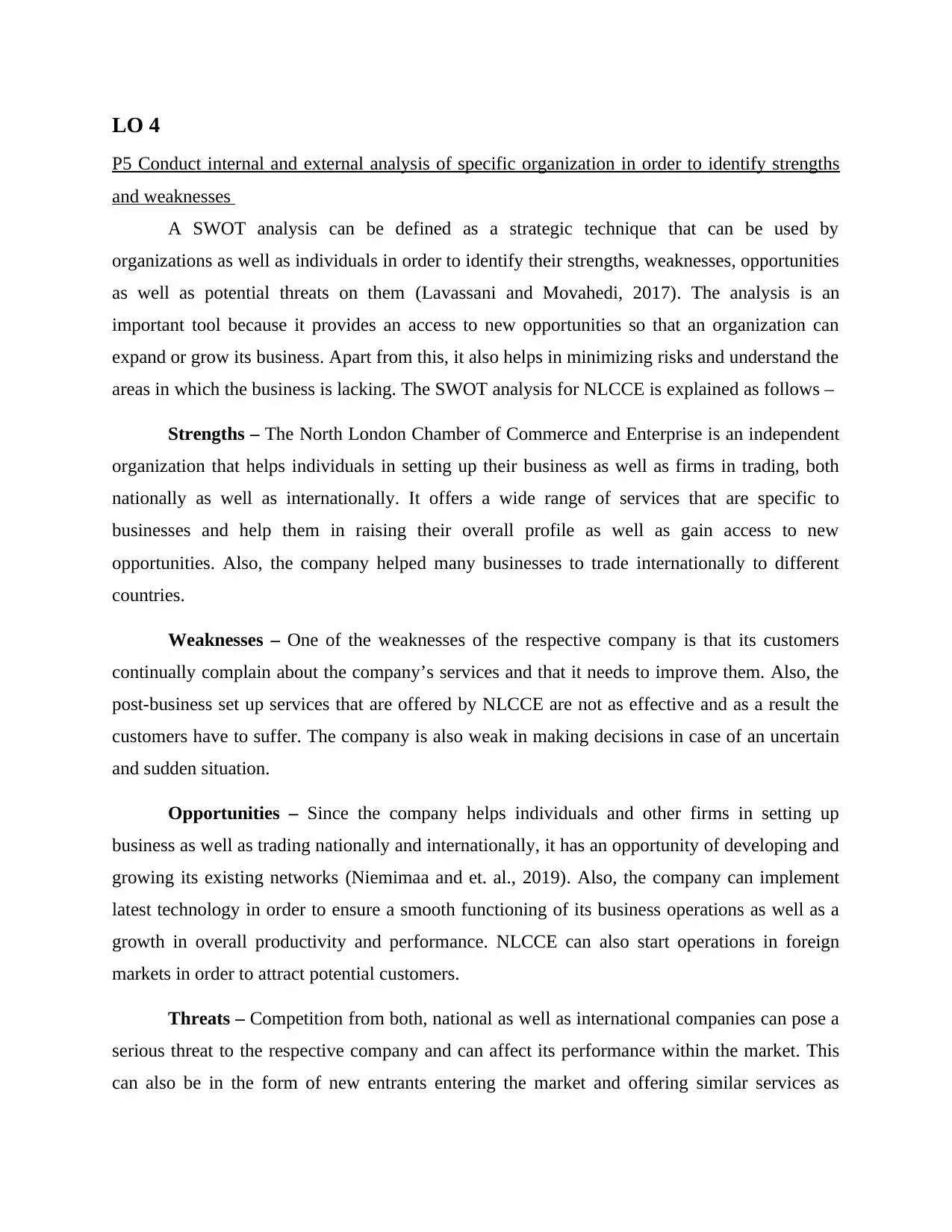
LO 4
P5 Conduct internal and external analysis of specific organization in order to identify strengths
and weaknesses
A SWOT analysis can be defined as a strategic technique that can be used by
organizations as well as individuals in order to identify their strengths, weaknesses, opportunities
as well as potential threats on them (Lavassani and Movahedi, 2017). The analysis is an
important tool because it provides an access to new opportunities so that an organization can
expand or grow its business. Apart from this, it also helps in minimizing risks and understand the
areas in which the business is lacking. The SWOT analysis for NLCCE is explained as follows –
Strengths – The North London Chamber of Commerce and Enterprise is an independent
organization that helps individuals in setting up their business as well as firms in trading, both
nationally as well as internationally. It offers a wide range of services that are specific to
businesses and help them in raising their overall profile as well as gain access to new
opportunities. Also, the company helped many businesses to trade internationally to different
countries.
Weaknesses – One of the weaknesses of the respective company is that its customers
continually complain about the company’s services and that it needs to improve them. Also, the
post-business set up services that are offered by NLCCE are not as effective and as a result the
customers have to suffer. The company is also weak in making decisions in case of an uncertain
and sudden situation.
Opportunities – Since the company helps individuals and other firms in setting up
business as well as trading nationally and internationally, it has an opportunity of developing and
growing its existing networks (Niemimaa and et. al., 2019). Also, the company can implement
latest technology in order to ensure a smooth functioning of its business operations as well as a
growth in overall productivity and performance. NLCCE can also start operations in foreign
markets in order to attract potential customers.
Threats – Competition from both, national as well as international companies can pose a
serious threat to the respective company and can affect its performance within the market. This
can also be in the form of new entrants entering the market and offering similar services as
P5 Conduct internal and external analysis of specific organization in order to identify strengths
and weaknesses
A SWOT analysis can be defined as a strategic technique that can be used by
organizations as well as individuals in order to identify their strengths, weaknesses, opportunities
as well as potential threats on them (Lavassani and Movahedi, 2017). The analysis is an
important tool because it provides an access to new opportunities so that an organization can
expand or grow its business. Apart from this, it also helps in minimizing risks and understand the
areas in which the business is lacking. The SWOT analysis for NLCCE is explained as follows –
Strengths – The North London Chamber of Commerce and Enterprise is an independent
organization that helps individuals in setting up their business as well as firms in trading, both
nationally as well as internationally. It offers a wide range of services that are specific to
businesses and help them in raising their overall profile as well as gain access to new
opportunities. Also, the company helped many businesses to trade internationally to different
countries.
Weaknesses – One of the weaknesses of the respective company is that its customers
continually complain about the company’s services and that it needs to improve them. Also, the
post-business set up services that are offered by NLCCE are not as effective and as a result the
customers have to suffer. The company is also weak in making decisions in case of an uncertain
and sudden situation.
Opportunities – Since the company helps individuals and other firms in setting up
business as well as trading nationally and internationally, it has an opportunity of developing and
growing its existing networks (Niemimaa and et. al., 2019). Also, the company can implement
latest technology in order to ensure a smooth functioning of its business operations as well as a
growth in overall productivity and performance. NLCCE can also start operations in foreign
markets in order to attract potential customers.
Threats – Competition from both, national as well as international companies can pose a
serious threat to the respective company and can affect its performance within the market. This
can also be in the form of new entrants entering the market and offering similar services as
⊘ This is a preview!⊘
Do you want full access?
Subscribe today to unlock all pages.

Trusted by 1+ million students worldwide
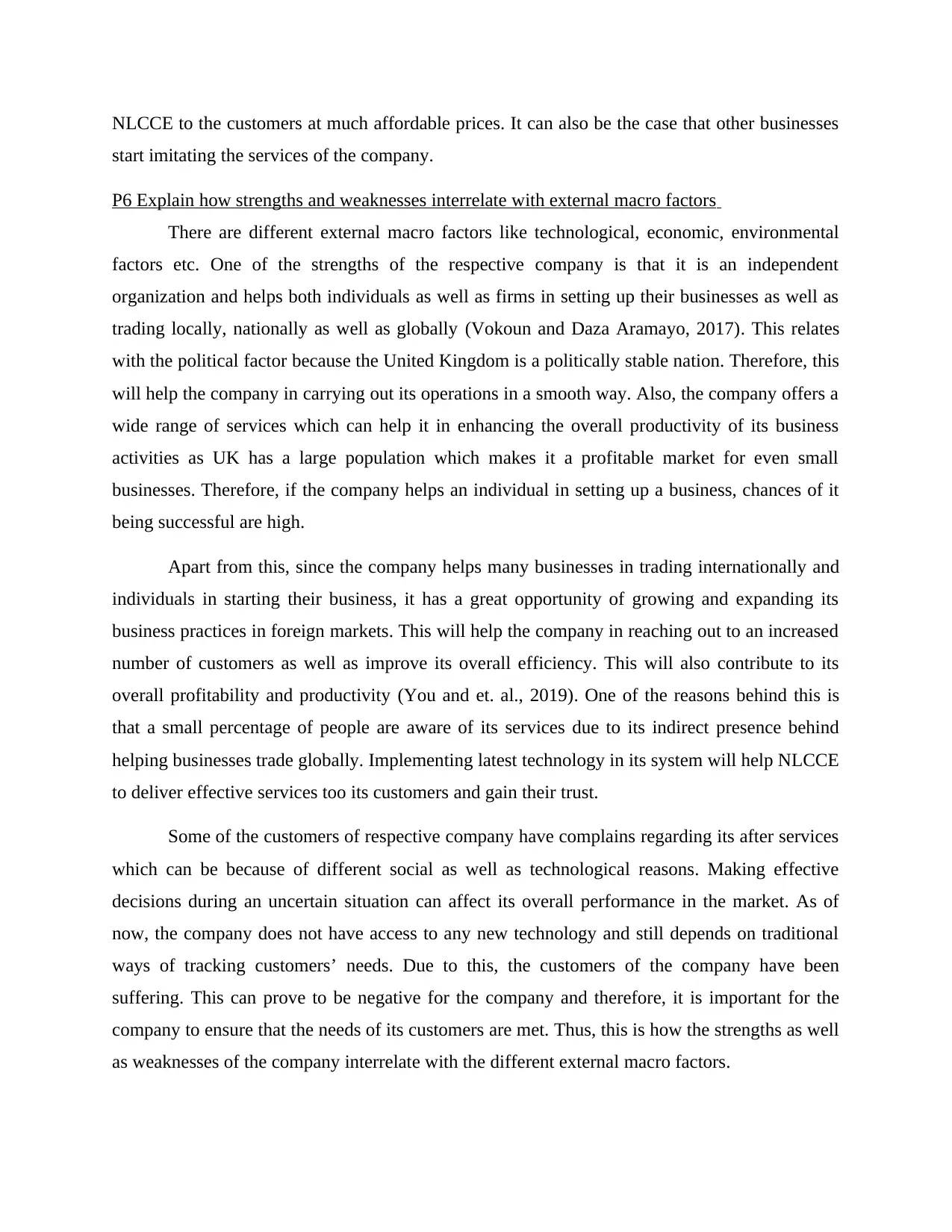
NLCCE to the customers at much affordable prices. It can also be the case that other businesses
start imitating the services of the company.
P6 Explain how strengths and weaknesses interrelate with external macro factors
There are different external macro factors like technological, economic, environmental
factors etc. One of the strengths of the respective company is that it is an independent
organization and helps both individuals as well as firms in setting up their businesses as well as
trading locally, nationally as well as globally (Vokoun and Daza Aramayo, 2017). This relates
with the political factor because the United Kingdom is a politically stable nation. Therefore, this
will help the company in carrying out its operations in a smooth way. Also, the company offers a
wide range of services which can help it in enhancing the overall productivity of its business
activities as UK has a large population which makes it a profitable market for even small
businesses. Therefore, if the company helps an individual in setting up a business, chances of it
being successful are high.
Apart from this, since the company helps many businesses in trading internationally and
individuals in starting their business, it has a great opportunity of growing and expanding its
business practices in foreign markets. This will help the company in reaching out to an increased
number of customers as well as improve its overall efficiency. This will also contribute to its
overall profitability and productivity (You and et. al., 2019). One of the reasons behind this is
that a small percentage of people are aware of its services due to its indirect presence behind
helping businesses trade globally. Implementing latest technology in its system will help NLCCE
to deliver effective services too its customers and gain their trust.
Some of the customers of respective company have complains regarding its after services
which can be because of different social as well as technological reasons. Making effective
decisions during an uncertain situation can affect its overall performance in the market. As of
now, the company does not have access to any new technology and still depends on traditional
ways of tracking customers’ needs. Due to this, the customers of the company have been
suffering. This can prove to be negative for the company and therefore, it is important for the
company to ensure that the needs of its customers are met. Thus, this is how the strengths as well
as weaknesses of the company interrelate with the different external macro factors.
start imitating the services of the company.
P6 Explain how strengths and weaknesses interrelate with external macro factors
There are different external macro factors like technological, economic, environmental
factors etc. One of the strengths of the respective company is that it is an independent
organization and helps both individuals as well as firms in setting up their businesses as well as
trading locally, nationally as well as globally (Vokoun and Daza Aramayo, 2017). This relates
with the political factor because the United Kingdom is a politically stable nation. Therefore, this
will help the company in carrying out its operations in a smooth way. Also, the company offers a
wide range of services which can help it in enhancing the overall productivity of its business
activities as UK has a large population which makes it a profitable market for even small
businesses. Therefore, if the company helps an individual in setting up a business, chances of it
being successful are high.
Apart from this, since the company helps many businesses in trading internationally and
individuals in starting their business, it has a great opportunity of growing and expanding its
business practices in foreign markets. This will help the company in reaching out to an increased
number of customers as well as improve its overall efficiency. This will also contribute to its
overall profitability and productivity (You and et. al., 2019). One of the reasons behind this is
that a small percentage of people are aware of its services due to its indirect presence behind
helping businesses trade globally. Implementing latest technology in its system will help NLCCE
to deliver effective services too its customers and gain their trust.
Some of the customers of respective company have complains regarding its after services
which can be because of different social as well as technological reasons. Making effective
decisions during an uncertain situation can affect its overall performance in the market. As of
now, the company does not have access to any new technology and still depends on traditional
ways of tracking customers’ needs. Due to this, the customers of the company have been
suffering. This can prove to be negative for the company and therefore, it is important for the
company to ensure that the needs of its customers are met. Thus, this is how the strengths as well
as weaknesses of the company interrelate with the different external macro factors.
Paraphrase This Document
Need a fresh take? Get an instant paraphrase of this document with our AI Paraphraser
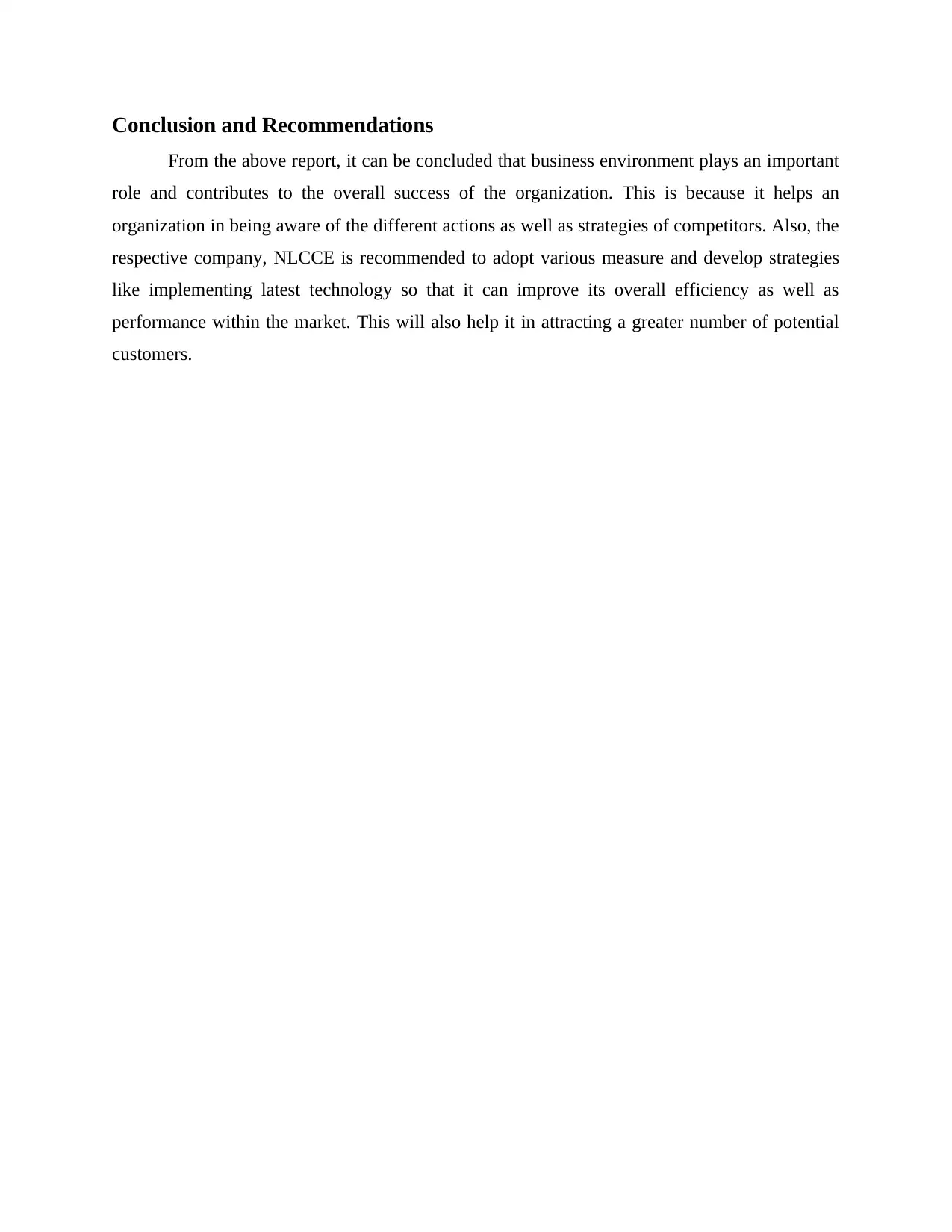
Conclusion and Recommendations
From the above report, it can be concluded that business environment plays an important
role and contributes to the overall success of the organization. This is because it helps an
organization in being aware of the different actions as well as strategies of competitors. Also, the
respective company, NLCCE is recommended to adopt various measure and develop strategies
like implementing latest technology so that it can improve its overall efficiency as well as
performance within the market. This will also help it in attracting a greater number of potential
customers.
From the above report, it can be concluded that business environment plays an important
role and contributes to the overall success of the organization. This is because it helps an
organization in being aware of the different actions as well as strategies of competitors. Also, the
respective company, NLCCE is recommended to adopt various measure and develop strategies
like implementing latest technology so that it can improve its overall efficiency as well as
performance within the market. This will also help it in attracting a greater number of potential
customers.
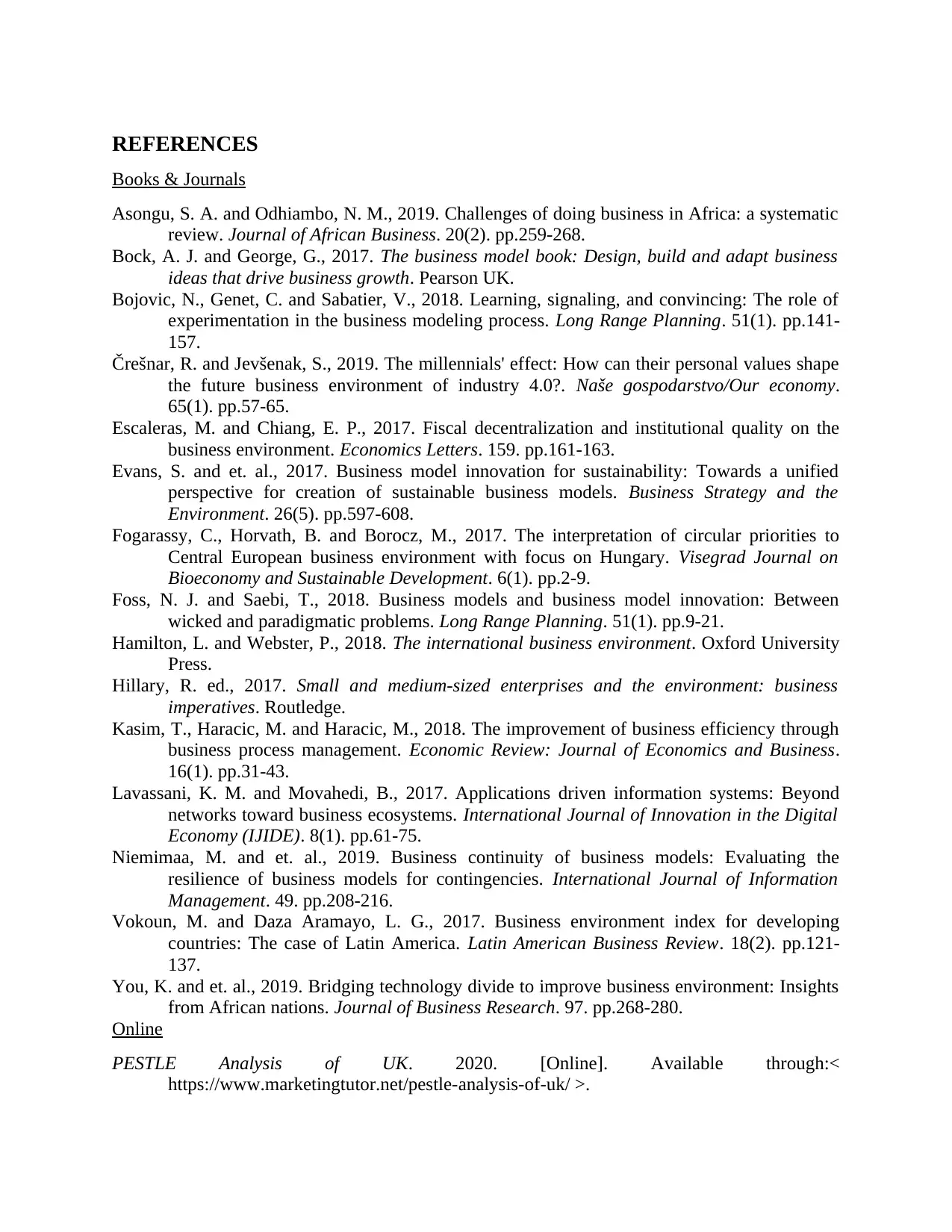
REFERENCES
Books & Journals
Asongu, S. A. and Odhiambo, N. M., 2019. Challenges of doing business in Africa: a systematic
review. Journal of African Business. 20(2). pp.259-268.
Bock, A. J. and George, G., 2017. The business model book: Design, build and adapt business
ideas that drive business growth. Pearson UK.
Bojovic, N., Genet, C. and Sabatier, V., 2018. Learning, signaling, and convincing: The role of
experimentation in the business modeling process. Long Range Planning. 51(1). pp.141-
157.
Črešnar, R. and Jevšenak, S., 2019. The millennials' effect: How can their personal values shape
the future business environment of industry 4.0?. Naše gospodarstvo/Our economy.
65(1). pp.57-65.
Escaleras, M. and Chiang, E. P., 2017. Fiscal decentralization and institutional quality on the
business environment. Economics Letters. 159. pp.161-163.
Evans, S. and et. al., 2017. Business model innovation for sustainability: Towards a unified
perspective for creation of sustainable business models. Business Strategy and the
Environment. 26(5). pp.597-608.
Fogarassy, C., Horvath, B. and Borocz, M., 2017. The interpretation of circular priorities to
Central European business environment with focus on Hungary. Visegrad Journal on
Bioeconomy and Sustainable Development. 6(1). pp.2-9.
Foss, N. J. and Saebi, T., 2018. Business models and business model innovation: Between
wicked and paradigmatic problems. Long Range Planning. 51(1). pp.9-21.
Hamilton, L. and Webster, P., 2018. The international business environment. Oxford University
Press.
Hillary, R. ed., 2017. Small and medium-sized enterprises and the environment: business
imperatives. Routledge.
Kasim, T., Haracic, M. and Haracic, M., 2018. The improvement of business efficiency through
business process management. Economic Review: Journal of Economics and Business.
16(1). pp.31-43.
Lavassani, K. M. and Movahedi, B., 2017. Applications driven information systems: Beyond
networks toward business ecosystems. International Journal of Innovation in the Digital
Economy (IJIDE). 8(1). pp.61-75.
Niemimaa, M. and et. al., 2019. Business continuity of business models: Evaluating the
resilience of business models for contingencies. International Journal of Information
Management. 49. pp.208-216.
Vokoun, M. and Daza Aramayo, L. G., 2017. Business environment index for developing
countries: The case of Latin America. Latin American Business Review. 18(2). pp.121-
137.
You, K. and et. al., 2019. Bridging technology divide to improve business environment: Insights
from African nations. Journal of Business Research. 97. pp.268-280.
Online
PESTLE Analysis of UK. 2020. [Online]. Available through:<
https://www.marketingtutor.net/pestle-analysis-of-uk/ >.
Books & Journals
Asongu, S. A. and Odhiambo, N. M., 2019. Challenges of doing business in Africa: a systematic
review. Journal of African Business. 20(2). pp.259-268.
Bock, A. J. and George, G., 2017. The business model book: Design, build and adapt business
ideas that drive business growth. Pearson UK.
Bojovic, N., Genet, C. and Sabatier, V., 2018. Learning, signaling, and convincing: The role of
experimentation in the business modeling process. Long Range Planning. 51(1). pp.141-
157.
Črešnar, R. and Jevšenak, S., 2019. The millennials' effect: How can their personal values shape
the future business environment of industry 4.0?. Naše gospodarstvo/Our economy.
65(1). pp.57-65.
Escaleras, M. and Chiang, E. P., 2017. Fiscal decentralization and institutional quality on the
business environment. Economics Letters. 159. pp.161-163.
Evans, S. and et. al., 2017. Business model innovation for sustainability: Towards a unified
perspective for creation of sustainable business models. Business Strategy and the
Environment. 26(5). pp.597-608.
Fogarassy, C., Horvath, B. and Borocz, M., 2017. The interpretation of circular priorities to
Central European business environment with focus on Hungary. Visegrad Journal on
Bioeconomy and Sustainable Development. 6(1). pp.2-9.
Foss, N. J. and Saebi, T., 2018. Business models and business model innovation: Between
wicked and paradigmatic problems. Long Range Planning. 51(1). pp.9-21.
Hamilton, L. and Webster, P., 2018. The international business environment. Oxford University
Press.
Hillary, R. ed., 2017. Small and medium-sized enterprises and the environment: business
imperatives. Routledge.
Kasim, T., Haracic, M. and Haracic, M., 2018. The improvement of business efficiency through
business process management. Economic Review: Journal of Economics and Business.
16(1). pp.31-43.
Lavassani, K. M. and Movahedi, B., 2017. Applications driven information systems: Beyond
networks toward business ecosystems. International Journal of Innovation in the Digital
Economy (IJIDE). 8(1). pp.61-75.
Niemimaa, M. and et. al., 2019. Business continuity of business models: Evaluating the
resilience of business models for contingencies. International Journal of Information
Management. 49. pp.208-216.
Vokoun, M. and Daza Aramayo, L. G., 2017. Business environment index for developing
countries: The case of Latin America. Latin American Business Review. 18(2). pp.121-
137.
You, K. and et. al., 2019. Bridging technology divide to improve business environment: Insights
from African nations. Journal of Business Research. 97. pp.268-280.
Online
PESTLE Analysis of UK. 2020. [Online]. Available through:<
https://www.marketingtutor.net/pestle-analysis-of-uk/ >.
⊘ This is a preview!⊘
Do you want full access?
Subscribe today to unlock all pages.

Trusted by 1+ million students worldwide
1 out of 13
Related Documents
Your All-in-One AI-Powered Toolkit for Academic Success.
+13062052269
info@desklib.com
Available 24*7 on WhatsApp / Email
![[object Object]](/_next/static/media/star-bottom.7253800d.svg)
Unlock your academic potential
Copyright © 2020–2025 A2Z Services. All Rights Reserved. Developed and managed by ZUCOL.





